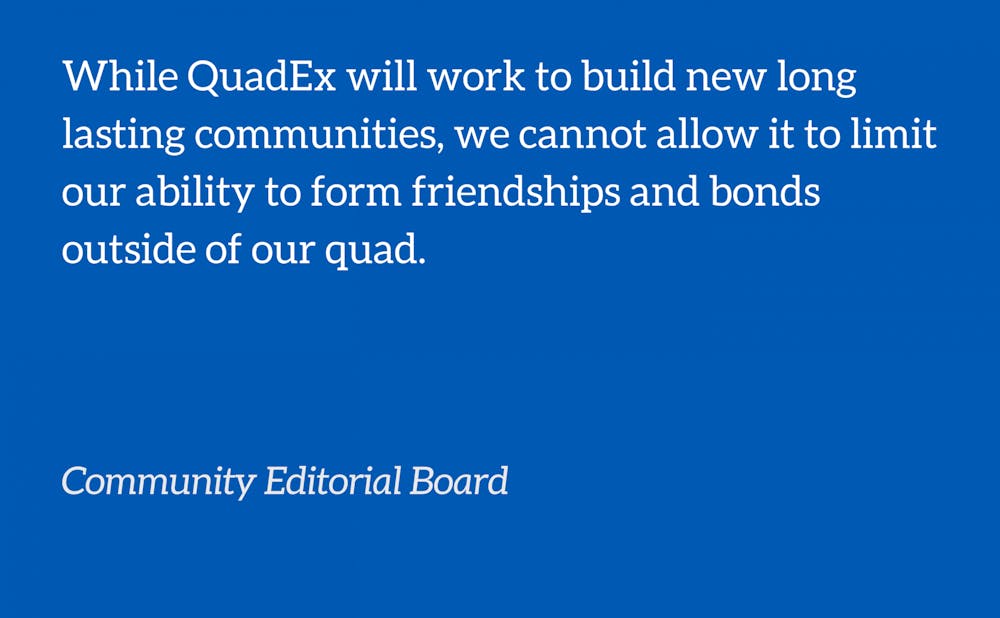You met them the first week of school. Over marketplace meals, ping pong matches and learning how to use the Duke laundry machines, they became your closest friends. You thought they would last forever. And then, rush came. Within the matter of weeks, your freshman year dorm became irrelevant to the social scene. Freshman year ends and your friendships are never quite the same.
This story is not uncommon. Duke spends thousands of dollars and hours each year forming a strong first-year community on East Campus. However, over the past few years and exacerbated by COVID-19, that freshman year vision is getting further and further away from reality.
Students begin their Duke journey in the welcoming bubble of East Campus, surrounded by the curiosity and excitement of their fellow first years. Over the years, Duke has made well-intentioned efforts to create a sense of belonging for freshmen by establishing programs such as Focus, Faculty in Residence and the East Campus Council. However, come spring semester, all of this effort to build community is challenged by the rush process. Dorm communities are traded for Selective Living Groups (SLGs), Living Learning Communities (LLCs) and Greek life. By the end of the rush process, only one-third of the student body remains unaffiliated, or independent, and is resolved to move to West Campus without being part of an official group.
Given the significant effort Duke places on building community during freshman year, there is a strong desire on campus, by both students and the administration, to not see this community building wasted. In September, Duke introduced the notion of QuadEx, a new residential model connecting East Campus Houses to West Campus Quads. The administration will implement these changes beginning with the Class of 2025. Now, all students will be affiliated with their assigned residential communities – for their entire undergraduate experience, with the objective of “enhancing social and intellectual connection, and fostering lifelong bonds”.
However, QuadEx is riddled with uncertainties because it leaves numerous essential aspects of Duke’s residential life as ill-defined. For instance, one major distinction about Duke’s model is that it will no longer offer university housing to Greek and non-Greek living groups. This renders the question of the implications of this decision for two-thirds of the student body. Will students in other residentially-linked programs such as Focus and Baldwin Scholars also miss the opportunity to reside as a group, losing an important component of their social and academic engagement?
The Covid-19 pandemic has shown us the importance of living together for these communities. Juniors who rushed in 2020 and did not get the residential component of their living groups now feel a disconnect from their SLGs. While most students at Duke form bonds with students in other quads or across campus, this demonstrates that living together is an essential component of building community. With the new QuadEx system, Duke asks us to trade one community for another.
This model could also have a negative impact on building community at Duke. What university officials see as a way to create tradition and identity could in fact restrict students to their Quad. Under this new model, upperclassmen can choose roommates, but only if they are members of the same Quad. Students will no longer be able to branch out of their assigned community, essentially limiting the scope of their residential experience. Continuing relationships can be wonderful, but what about building new ones?
Aside from opaqueness from administration about specific details within the model, many of these concerns actually stem from uncertainty about the specific goals that Duke is trying to achieve with QuadEx. Perhaps this new model is an attempt to establish a housing system similar to other elite universities or create more housing space for a future increase in the student body. It could also represent a way of decreasing the influence of student living organizations on campus. However, these unclear goals simply raise more questions. If student living organizations move off-campus, will Duke end the three-year on-campus residence requirement?
Last year when Vice Provost for Undergraduate Education Gary Bennett announced this new residential plan, he declared that, in the future, one of the first questions Duke alumni will ask each other is what Quad they were a part of. Is this really what we want to focus on when reflecting upon our college experience in the future? For many, the magic of Duke is the freedom students have to interact with all different types of people and create their own web of relationships, whether that is through classes, clubs, or by living in different dorms throughout the years. Residential life is a significant piece of our social life at Duke, but it is simply that – a piece. While QuadEx will work to build new long lasting communities, we cannot allow it to limit our ability to form friendships and bonds outside of our quad.
We hope that as the administration further unveils these QuadEx plans and releases a more transparent set of goals behind these changes, students will gain a better understanding about what to expect from Duke residential life going forward. When Duke alumni ask each other which quad they were a part of, we hope they will see this as an opportunity for added community building and even friendly rivalry, not a limiting factor in their time at Duke.
Get The Chronicle straight to your inbox
Signup for our weekly newsletter. Cancel at any time.

